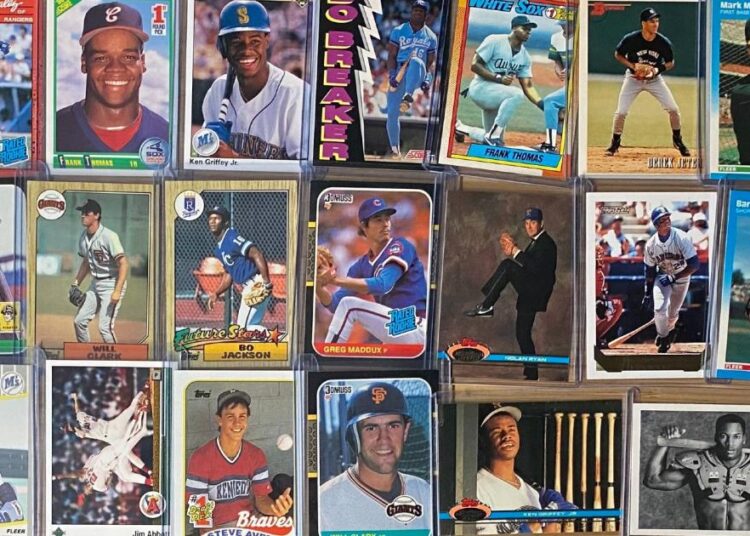I love the Junk Wax Era of baseball cards. But if you’ve read anything baseball-card related I’ve written the past few years, or if you follow me on Twitter, you already knew that.
Those cards were a constant source of enjoyment and baseball education during my childhood. Even now, they fuel an overwhelming sense of nostalgia every time I open a pack or sort through a stack of cards. And, yeah, I’ve used that mild obsession as content inspiration during the coldest months of the baseball offseason the past few years.
MORE: Ranking the top 15 sets of baseball cards from the ’80s and ’90s
Last February, I wrote a long ode to the iconic 1987 Topps set, the crown jewel of the Junk Wax Era (in my humble opinion). I’ve ranked the best and worst sets of the Junk Wax Era. I’ve researched Donruss’ iconic Rated Rookie cards (with a breakdown of the career WAR of every Rated Rookie from 1984 to 1993). I’ve ranked Bo Jackson’s best baseball cards, almost exclusively from the Junk Wax Era. I wrote about selling boxes of cards from the Junk Wax Era at a baseball card show. Heck, back in 2014 I wrote about the first boxes of Junk Wax Era cards that I’d opened in a few decades.
Folks, my secondary Twitter handle is literally @myjunkwax.
Anyway, I thought I had thoroughly mined the Junk Wax Era for labor-of-love content ideas. Then, one day recently, I had another idea (spoiler: it probably won’t be the last one).
So today, I present my ranking of the Junk Wax Era, arranged by years. Basically, I’m comparing 1987 to 1991 to 1988 and so forth, mostly considering the primary set releases. I can already feel some of you rolling your eyes in disgust. “Again, Ryan?” But I know some of you are already scrolling down to see which year came in last. You are my people.
Let’s start by defining the “Junk Wax Era.” It’s a term of endearment, at least for me and most of the collectors I know. For a lot of us, it was our entry into the hobby, one pack at a time from pretty much any gas station, card shop, grocery store or other random retail place that had a box sitting on the bottom row of the candy aisle. And, yeah, the packs were everywhere. Topps was the first company to set a cinder block on the “print cards” button and walk away for days and weeks and months, but Donruss, Fleer and others soon followed.
We didn’t call it the Junk Wax Era back then, of course. It’s a label given in retrospect. Junk because of the massive print runs — they printed so many cards that they’re all, essentially, worthless junk — and Wax because most of the packs were sealed with wax. As for how many cards were printed, the companies either don’t have or won’t release the real numbers — believe me, I’ve asked — so last February, while reporting my ode to the iconic 1987 Topps set, I spoke with Rich Klein, a long-time collector and store owner who then worked for Beckett as a price-guide guru for a couple decades.
If anyone would have an educated guess, it’s him.
“I think the number of sheer cards they produced in 1987 would floor you,” Klein told me. “I think it would floor you with the hundreds of millions, maybe 200 or 300 million cards. There’s still no shortage of 1987 Topps. There’s no shortage of 1988 Topps. There’s no shortage of 1989 Topps. I remember in 1989 I saw a sales list, and you could get 800 copies of any 1989 Topps card you wanted.”
Anyway, I’m getting off track. For our purposes, we’re starting the Junk Wax Era in 1987 and ending it with the 1993 sets. By then, companies had started to realize, at least to a certain extent, that maybe it was a good idea not to completely flood the market with more cards than anyone could possibly handle. Maybe that’s off by a year in either direction, but that’s what we’re going with.
So, here’s the definitive ranking for the seven years of the Junk Wax Era.
7) 1988
Remember, I say this from a place of love. The problem with the 1988 sets, especially when contrasted with the previous year’s releases, is this: It’s way too easy to find fault with the four primary sets. Topps had another classic-looking design, but missed on just about every rookie other than Tom Glavine and Al Leiter, and they didn’t even actually use Leiter on his card, until correcting the error. There was no Gregg Jefferies, no Mark Grace, no Roberto Alomar, no Ron Gant, no Jay Buhner and so on. The Donruss rookie checklist was much better — though, somehow, they didn’t slap Rated Rookie logos on Jefferies or Glavine — but the space-age design was, and is, not great.
With Fleer, you either loved or hated the design, a big departure from more classic designs of the previous several seasons, with the white borders and red-and-blue lines floating randomly across the backdrop. This Twitter comment from my “worst sets” ranking made me laugh: “1988 Fleer resembled a Fruit Stripe gum wrapper way too much.” Fleer missed Jefferies, Alomar and Buhner, too, but kudos for being the only company to include an Edgar Martinez rookie. Score entered the picture as the fourth card company, with a focus on action photos, extensive write-ups on the backs of the cards and bright different-colored borders. The latter part of that equation didn’t always sit well with collectors, but they’ve aged well.
Best set: 1988 Topps Traded. Honestly, I hate choosing a traded set, but it’s hard to single out any of the primary sets (not a single one made my list of the 13 best Junk Wax sets). With this particular Traded offering, not only did you get all the rookies that the base set missed, but Topps added the Team USA cards, which meant you got future stars Jim Abbott, Robin Ventura, Andy Benes and Tino Martinez. There are more good cards in this 132-card set than the entire 792-card flagship set. And the set was printed on brighter card stock, which makes the orange backs really pop.
Worst set: 1988 Donruss. Even though Donruss probably had the best rookie selection, this one gets the nod. I’ll just use what I wrote here: “… it looks like Donruss tried to be creative but wound up with uninspiring all the same. The photography, kids, ain’t great. It looks like half of the pictures were taken with disposable cameras (‘Look at me and smile. Or don’t. It doesn’t matter to us.’).” That said, I’ll still buy a cheap box when I happen across one.
Best card: 1988 Donruss Gregg Jefferies. He was THE GREATEST PROSPECT EVER, and Donruss had his card. Fun fact: He was not a Rated Rookie in the 1988 set, but he was a Rated Rookie in the 1989 set.
Honorable mention: 1988 Score Rookie & Traded Craig Biggio. This card just works, with the set’s orange border matching the Astros’ color scheme, and Biggo standing there like a statue, waiting for a pitch with his arms in textbook position and intensity and focus on his face.
6) 1992
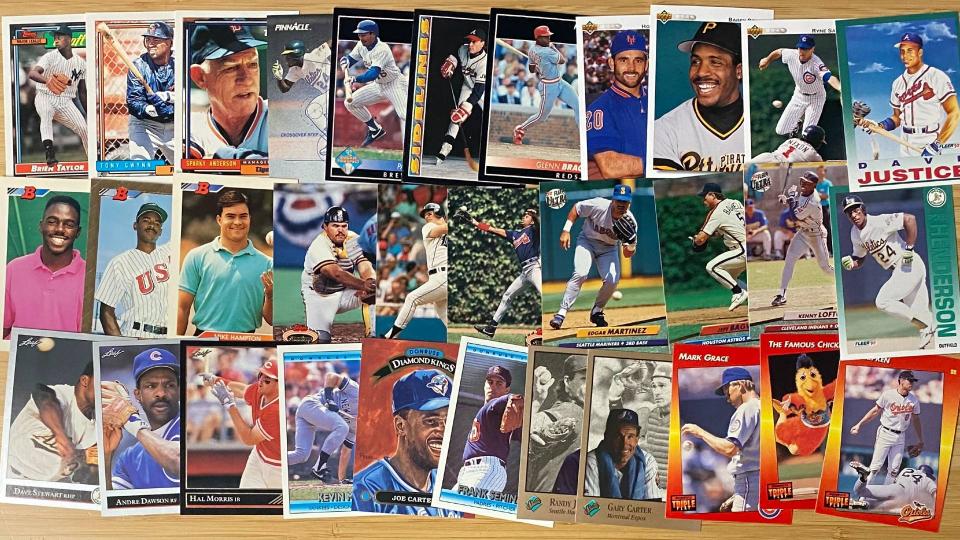
It was officially hard to keep up with everything by 1992. Every card manufacturer had multiple sets, and every set had inserts, autographs and whatever. That wasn’t necessarily a bad thing, but it certainly was overwhelming. There were new sets — hi, Pinnacle and Triple Play! — and completely remade sets — Bowman as a premium product and Fleer Ultra with a glossy, gold-leaf makeover that was so good it completely made up for the blah 1991 product.
And maybe the most influential element of the 1992? This was the first year of the “parallel” cards in packs, for every card in the set. Before, you could buy Topps’ Tiffany sets or Fleer’s Glossy set, but they were available only as full sets. But this year, Topps introduced the rather stunning Topps Gold set, and Leaf gave us Black Gold cards. You knew where those cards were in the packs, and you’d look at that one last, as the kicker. All the refractor/prizm/etc. parallels — the rainbow chases — that dominate the market now? It all originated in 1992.
Best set: 1992 Bowman. Not only was the product now glossy, but it was hard to find and had what felt like half of the players not wearing a baseball uniform. The fashion choices were … interesting. Let’s just say it’s probably not Chipper Jones’ personal favorite card. But this set has held up in a way that very few sets have from this era. Trying to find a box for less than $400 now is an exercise in futility.
Worst set: 1992 Donruss. I’m probably in the minority here, but I wasn’t a fan of the design, at all. Still am not a fan. The set wasn’t all bad — the manufacturers had mostly figured out what pratfalls to avoid — but it was uninspiring. Donruss did rebrand the Diamond Kings as an insert set, which was cool, and the Elite Series chase cards were again in demand.
Best card: 1992 Bowman Mariano Rivera. In retrospect, it’s Skinny Mariano in khaki pants leaning against a support beam. In that era, though? Probably Mike Piazza from that same set.
Honorable mention: Again, in retrospect, any of the Derek Jeter minor league/draft pick cards, like the Upper Deck Minor Leagues set, or Classic 4-Sport Draft Picks, or Front Row cards.
5) 1990
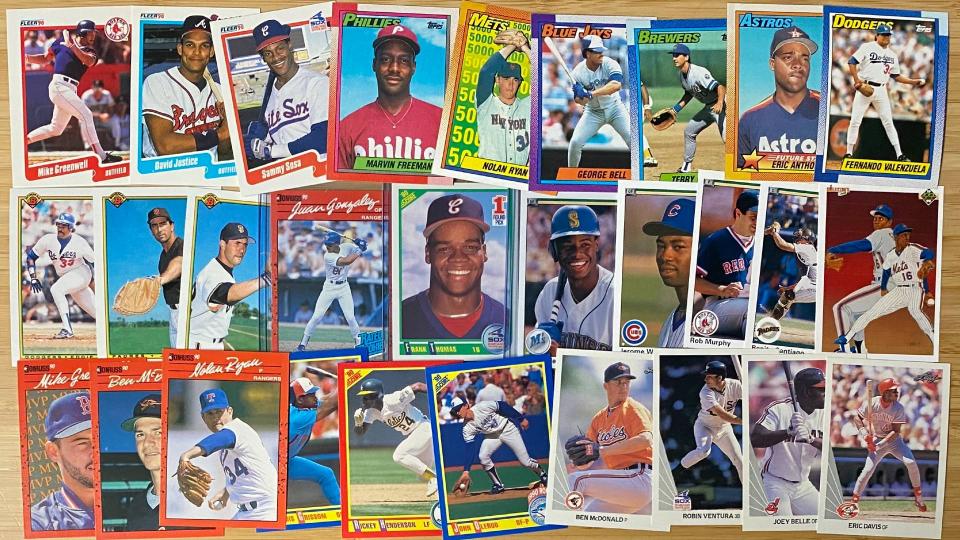
This is a year of great contrast between the top and bottom of the product spectrum. Up high, you have Leaf’s stellar debut, Score’s return to its roots and Upper Deck’s continued excellence (the Heroes insert series, with Reggie Jackson autos, was a big addition to the hobby equation). At the bottom, arguably Fleer’s worst product ever (with 1991’s mustard leanings and 1995’s chaos theory product in that conversation), Topps drastically changing its design philosophy and a Donruss paint-splatter product that was quite divisive. Truth be told, I like that set, but when I asked for opinions on Twitter, I was shocked at how many people despise that design.
One thing about the crop of 1990 rookie cards that stands out is this: Not many of the players lived up to their hype — Frank Thomas being the notable Hall of Fame exception — but that doesn’t mean their RCs weren’t tiny slices of gold back in the day. The hype was fun. Great players, great careers, just not quite at the Frank Thomas level. But think about it: David Justice, Kevin Maas, John Olerud, Juan Gonzalez, Deion Sanders, Bernie Williams, Robin Ventura, Steve Avery, Moises Alou and so on. Just because they’re all available for a buck or less now doesn’t diminish the thrill of collecting back then.
Best set: 1990 Leaf. The folks at Donruss clearly saw Upper Deck’s success in 1989 and copied pretty much everything other than the signature UD hologram with the company’s entry into the “premium” market. And you know what? It worked. The photography was a big step up from base Donruss sets of the past. They nailed the rookie selections — not only did they make the best Frank Thomas rookie card (competition was fierce), but they had Sammy Sosa, Larry Walker and John Olerud. And they did well with pretty much every future Hall of Famer’s card, especially the second-year Griffey.
Worst set: 1990 Fleer. It’s just … not good. It’s not just that the photos were eternally off-center — though they certainly were — but the card edges were often so rough that you wondered whether they ever changed the blades. The photography choices were the worst of the Fleer run (and that’s saying something) and maybe that’s something they could have gotten away with in earlier years, but with Upper Deck’s arrival and focus on photography in 1989 and other sets stepping up their game in 1990, Fleer stood out like a sore thumb. And it didn’t help that they missed Frank Thomas in the base set.
Best card: 1990 Score Bo Jackson football/baseball. You know the one. It’s on the short list of most iconic baseball cards in the hobby’s history. Bo standing there wearing his football pads, holding the baseball bat across his shoulder. The back of the card, just “BO” … just brilliant. Love that whole 1990 Score set, by the way.
1.2.23 #RFcod: 1990 Score Bo Jackson FB/BB
just an all-time great card that’s as cool today as it was back in 1990.
had so much fun with the Griffey card thread yesterday, let’s run it back with Bo!
reply with a pic of one of your favorite Bo cards … RCs, football, whatever pic.twitter.com/Mf2cfPJe4t
— ryan fagan (@myjunkwax) January 2, 2023
Honorable mention: 1990 Leaf Frank Thomas. The four sets that had The Big Hurt — Leaf, Topps, Score and Bowman — all produced great cards. But Leaf was the “premium” card and still carries that extra sense of wonder and awe (and price) the others don’t have.
4) 1991
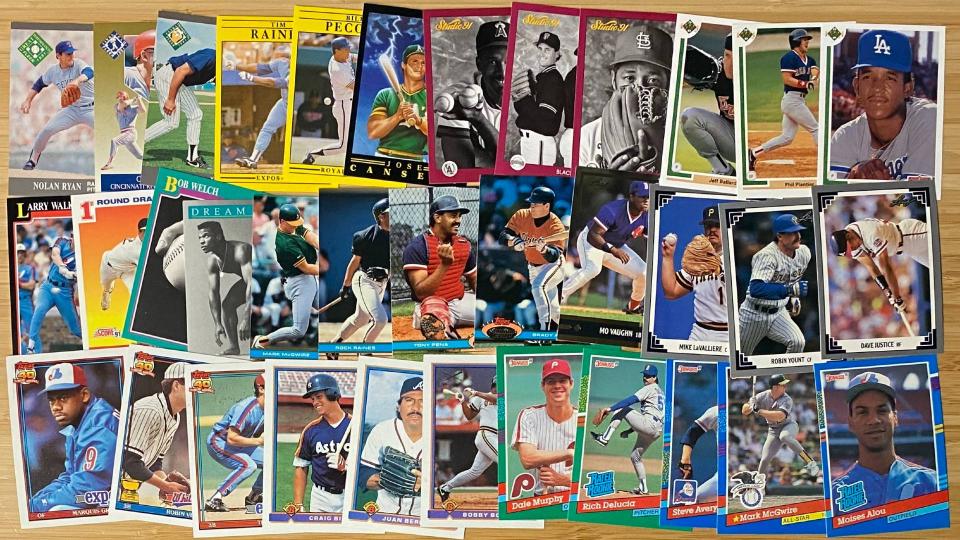
Two years after Upper Deck changed the collecting game (spoiler), Topps raised the bar again with Stadium Club, the company’s long-awaited entry into the premium market. Studio, another Donruss/Leaf product, offered a different approach, with almost a Glamour Shots feel that wasn’t particularly well-received at the time, but went a long way toward showing the players’ personalities (especially with the card backs). Any set that has a card of a player with a parrot sitting on his shoulder is a win for me. I’m a huge fan. Score went all-in with the superstar-per-pack idea, creating a ton of subsets that pretty much guaranteed a star or future Hall of Famer in every pack — there were six different Ken Griffey Jr. cards between Series 1 and 2, for example. Upper Deck was, again, outstanding.
With its base set, Topps decided that it was more important to highlight its 40th Anniversary logo than, y’know, actually making player names readable on the front. This was the last year of gum in the Topps packs, too. Annoying. Donruss and Fleer base sets… meh, again (though Donruss’ Elite Inserts — numbered! — still represent a Grail quality for some collectors). Fleer joined the “premium” club with Fleer Ultra … kinda. Just calling a product premium doesn’t make it so. Donruss messed up its second-year Leaf product, creating a claustrophobic border-heavy design and forgetting the “limited” part of the premium card equation. Bowman delivered with the rookies, though the overall product was uninspiring and in need of a rethinking that would happen the next year.
Best set: 1991 Stadium Club. Even though the boxes/packs now cost about a quarter as much as they did then, the set stands the test of time, with the full-bleed photos, the gold foil accents and breathtaking photography choices. And, as odd as this sounds, the Stadium Club cards just smelled different when you opened those packs (once you saved up the $4-5 to get one). If you know, you know.
Worst set: 1991 Fleer. The yellow. Oh, the yellow. Not great, Bob. But the Pro Visions inserts? Elite of the elite. Inner circle insert set of all time.
Terry Smith had a vision of how athletes should be portrayed. He sent his art off to the card companies in the late 80’s and then didn’t hear anything for 2 years. #baseballcards #fleer #sportscards #thehobby #whodoyoucollect #footballcards #basketballcards pic.twitter.com/0hwUPNKmQI
— TheCardLifeTV (@TheCardLifeTV) January 9, 2023
Best card: 1991 Upper Deck Michael Jordan short print. Foreshadowing at an epic level.
Honorable mention: 1991 Stadium Club Nolan Ryan. The strikeout king throwing a pitch in a tuxedo? Yes, please. Loved Dave Stewart’s card of him doing the same thing.
3) 1993
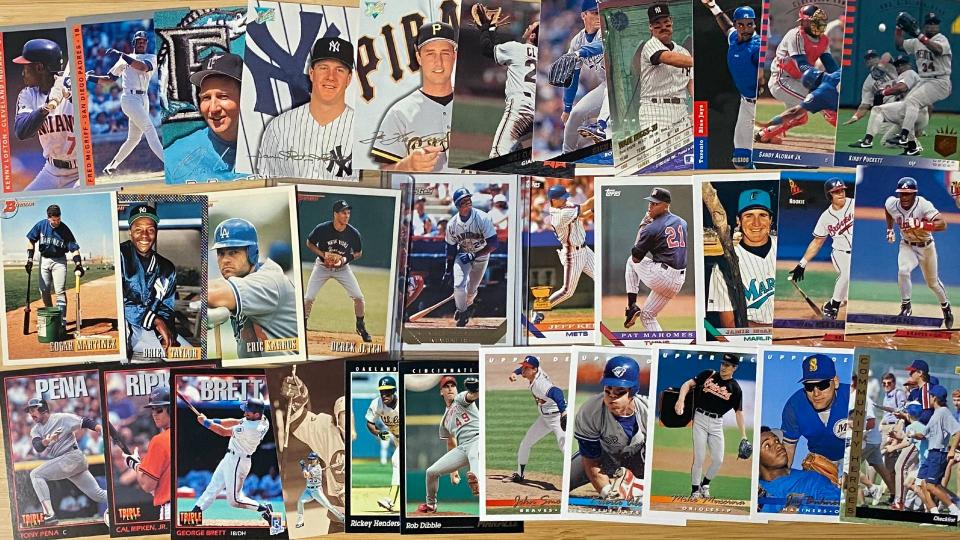
By this point in the Junk Wax Era, the companies had figured out what did and did not work. They still produced too much quantity, for the most part, but there was a quality to the products — photography, card stock, quality control — that didn’t exist just a few years later. Just stellar products across the board. One of my all-time favorite sets, 1993 Studio, almost gets lost in the mix, along with Upper Deck’s super-premium short-print product, Leaf’s reinvention as a borderless, photography-driven set (with stunning city-oriented backgrounds on the back of the cards) and the introductions of Topps Finest and Fleer Flair. Pinnacle’s second offering was more of the same, and that was a good thing (Pinnacle’s subsets — The Idols, Sidelines and Shades, etc. — were elite).
For better or worse, this was the beginning of the lottery aspect of collecting; sure, you could open packs and get a Griffey, but you also might get an autograph of a Hall of Famer. And, yeah, it was worth a little more per pack for that chance. Pretty clear the card companies noticed that, eh?
Best set: 1993 Upper Deck. Yeah, maybe Upper Deck’s short-print offering was more influential and the Finest and Flair debuts were more revolutionary, but I don’t care. I irrationally love the 1993 Upper Deck set. For my money, this set features the best photography in any baseball set that I’ve ever seen. Every card has something — emotion, intensity, humor, detail — on both front and back. I have yet to tire of opening packs (literally have opened probably five boxes the past three years) except when improperly stored boxes can make the packs brickish.
Worst set: 1993 Score. To be honest, I don’t have any real problem with this set. It’s just “OK, sure” in a time when there was a lot of “oh, that’s cool” on the market. It is the goofiest of the Jeter rookie cards.
Best card: 1993 Upper Deck short-print Derek Jeter. It’s fun to occasionally look through an old Beckett and see that you could have picked up as many mint copies of this card as you wanted for $3, then realizing this was the one card that actually, legitimately, could have helped you fund your retirement, and all that money you spent on Juan Gonzalez or Kevin Maas rookie cards was wasted. Or maybe that’s not so much fun.
Honorable mention: 1993 Triple Play Ken Griffey Jr. Nicknames. For real, not sure how you pick an honorable mention from this year, so I’ll just go with this one. Love, love, love the Nicknames insert set from Triple Play. Stands up to all the premium cards. And seeing “Junior” splashed across the top of the card … just outstanding.
2) 1989
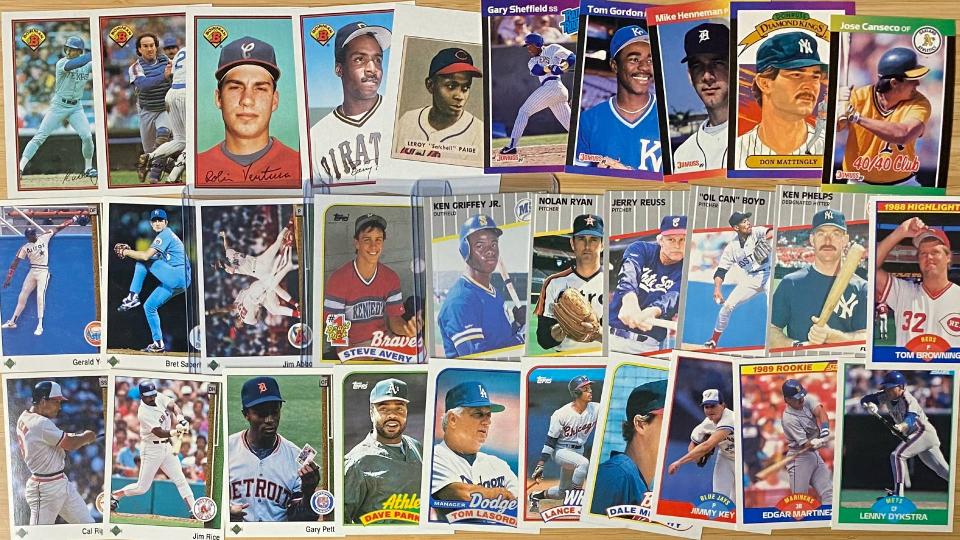
This year is known for two things: Ken Griffey Jr. rookie cards and the arrival of Upper Deck on the collecting scene. Both were industry-altering developments. And the combination of the two, Griffey’s Upper Deck RC? It’s on the short list of most iconic, recognizable cards in the history of the hobby, along with the 1952 Topps Mickey Mantle and the T-206 Honus Wagner. I loved the designs for both Fleer and Donruss, though both companies seemed to have more centering issues in 1989 than they had the previous few seasons. Not as bad as their 1981 debuts, of course, but still not great. Both sets nailed the Griffey selection, though a centered Griffey Rated Rookie can be hard to find.
Bowman had a good Griffey, too, even though he appears to have six fingers on the card (seriously, look). Topps had long owned the Bowman name but kept it dormant until 1989, and it was an interesting addition to the equation. The oversize cards didn’t fit in kids’ binders, which was annoying, but the set had tons of rookies nobody else did — hi, Jerome Walton! — and that was all kinds of fun. Topps and Score both missed on Griffey, and I’m not sure how. This was the last true “classic” Topps look, and everyone loved the No. 1 draft picks subset — the Steve Avery RC is a truly great card — but there was no Griffey. Did I mention that the set didn’t have Griffey, even though they had a No. 1 draft picks subset, and Griffey was a No. 1 overall draft pick (a year earlier, I know)? And Score … we’ll get there in a minute.
Best set: Upper Deck, and it’s not even close. They had not only the iconic Griffey, but RCs of Gary Sheffield, John Smoltz, Randy Johnson and Craig Biggio. The triple-exposure card of Nolan Ryan blew kids’ minds across the country. The better, glossy card stock. The action photos on the back of the cards. The Dale Murphy reverse-negative error. This set had it all.
Worst set: I know some people love the 1989 Score set and call it clean and crisp, but to me it’s just bland. It’s almost like they heard so much criticism for their use of bold colors in 1988 that they went running in the opposite direction. There’s nothing remarkable about it. Oh, and they missed on Griffey, too.
Best card: 1989 Upper Deck Ken Griffey Jr. Duh.
Honorable mention: 1989 Fleer Billy Ripken FF. You know what the FF stands for. I got one from a pack in 2021, for the first time in my life, and a jolt of excitement surged through my body. I can’t even imagine what it would have been like holding that as a teenager.
1) 1987
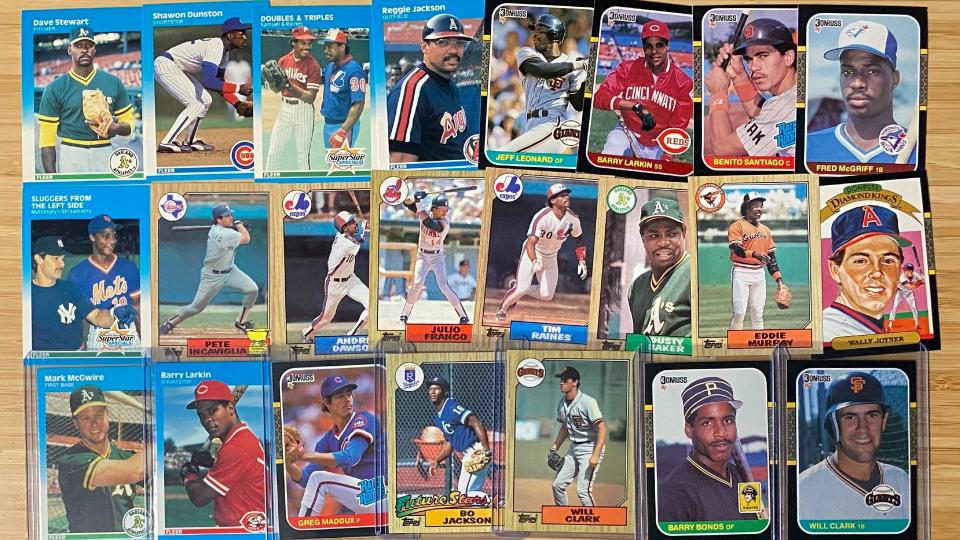
Not that you care, but I’m writing this part of the ranking last, and I’m struck by how much simpler of a time it was in 1987 than it would be just a few years later. Sure, there were the secondary sets — Highlights and The Rookies from Donruss, Fleer’s Star Stickers and assorted drug-store highlight sets — and Sportflic’s second offering, but mostly it was just about three card companies and their base sets. And, folks, all three companies hit home runs this year. Three very different designs, all striking and memorable in their own way. Not a damn flaw in the mix. The focus was on the rookies (so many elite rookies) and the future Hall of Famers (at least 45 cards, and that doesn’t include Clemens, Bonds, Rose, McGwire, Mattingly, Murphy, etc). Simple, stellar, satisfying.
Best set: 1987 Topps. But you already knew that.
Worst set: 404 – File Not Found
Best card: 1987 Topps Bo Jackson. Again, but you already knew that. It’s basically the perfect baseball card.
Honorable Mention: 1987 Donruss Greg Maddux. Kudos to Donruss for not only being the only one of the three to include a true Maddux RC — Topps and Fleer had him in their update/traded sets — but also giving him a Rated Rookie logo and using a pic of him with that sweet mustache.
Read the full article here











